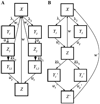No coexistence for free: neutral null models for multistrain pathogens
- PMID: 21352747
- PMCID: PMC3099423
- DOI: 10.1016/j.epidem.2008.07.001
No coexistence for free: neutral null models for multistrain pathogens
Abstract
In most pathogens, multiple strains are maintained within host populations. Quantifying the mechanisms underlying strain coexistence would aid public health planning and improve understanding of disease dynamics. We argue that mathematical models of strain coexistence, when applied to indistinguishable strains, should meet criteria for both ecological neutrality and population genetic neutrality. We show that closed clonal transmission models which can be written in an "ancestor-tracing" form that meets the former criterion will also satisfy the latter. Neutral models can be a parsimonious starting point for studying mechanisms of strain coexistence; implications for past and future studies are discussed.
Figures




References
-
- Andersson DI. Persistence of antibiotic resistant bacteria. Curr. Opin. Microbiol. 2003;6(5):452–456. - PubMed
-
- Anderson RM, May RM. Infectious Diseases of Humans: Dynamics and Control. Oxford: Oxford University Press; 1991.
-
- Andersson DI, Levin BR. The biological cost of antibiotic resistance. Curr. Opin. Microbiol. 1999;2(5):489–493. - PubMed
Publication types
MeSH terms
Grants and funding
LinkOut - more resources
Full Text Sources
Medical
Miscellaneous

